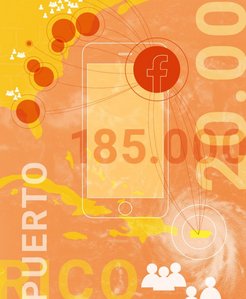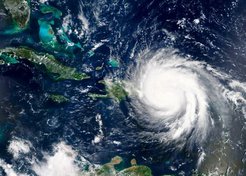How Facebook is helping to measure migration
It is almost impossible to rapidly obtain figures on migration movement following natural disasters, especially using only traditional sources such as government statistics. Data from social networks such as Facebook is opening up completely new possibilities. This enabled us to track migration movements from Puerto Rico to the USA following Hurricane Maria in the autumn of 2017.

Hurricane Maria raged in parts of the Caribbean in September 2017. The island of Puerto Rico, an incorporated territory of the United States, was hit particularly hard: countless houses were destroyed, the electricity and water supply collapsed and the medical infrastructure suffered severe damage. As a result, almost 3,000 people died in Puerto Rico alone. Natural disasters such as these frequently cause part of the population to emigrate. But until now, it has been difficult to track who goes where and when, and particularly to do so in a timely manner. However, for authorities and aid organisations to be able to support those affected, this data would be important, whether or not they want to remain, begin a new life elsewhere or return home. These questions cannot be answered using only traditional data sources such as official statistics. Particularly, the authorities in the USA do not keep monthly records of migration within US states and US territories such as Puerto Rico. Yet this is precisely what would be required to track disaster-related migration and displacement.
This is why, together with Monica Alexander from the University of Toronto and Kivan Polimis from the University of Washington, we exploited an alternative data source: Facebook. In addition to the counts of those concerned, anonymised Facebook data, which is collected regularly for advertisers, provides precise demographic data on the genders and ages of migrating users. This enabled us not only to track how many people moved following Hurricane Maria, but also whether as many men as women emigrated and their ages at that time. Even compared to other unconventional sources such as passenger lists and mobile phone data, this is an additional benefit.
This social network is mainly used by younger people
Our team had already started to collect data from the Facebook advertising platform in January 2017, so we already had data on migratory movement prior to the natural disaster when Hurricane Maria struck Puerto Rico the following September and we were able to collect further data during the following period. This is important, as Facebook data is only revealing valuable information if trends are observed over a long period and in comparison with other countries.

Another factor must be taken into account when working with Facebook data: this social network is mainly used by younger people, whereas older people are underrepresented in relation to their share of the total population. We therefore used a suitable statistical model to correct for this distortion of the data, after which we could clearly see a sharp increase in migration from Puerto Rico to various US states in the immediate aftermath of the natural disaster. We found that about 185,000 people , which is more than five percent of the population, had emigrated from the island to continental US by January 2018. These were primarily young people aged between 15 and 30 y ears. We also found that, for the most part, these young adults migrated to US states with pre-existing Puerto Rican communities such as Florida, Connecticut and Pennsylvania, which saw the biggest increases in Puerto Rican population.
Conversely, this means that it was mainly older people who stayed put. Our data generally confirms findings from other studies, according to which people require a certain amount of resources to be able to react quickly to a disaster. Being able to emigrate depends on one’s health and financial situation. Regardless of how devastating the situation is, the frail and the poor remain behind.
Furthermore, we analysed data from the Facebook advertising platform for the year after the disaster and discovered that around 20,000 people returned to Puerto Rico between January and March 2018. This trend to return to the old home emerged once the worst effects of the hurricane were under control. Using traditional data sources would not have enabled us to track this migration movement.
Reliable data support relief efforts in the event of a catastrophe
A sound grounding in statistics and programming skills are prerequisites for compiling and evaluating such unconventional data, so our project involved a collaboration between researchers from the fields of demography, data science and statistics. We jointly developed new methods before using additional data sources to independently verify our results. The post-Hurricane Maria migration example demonstrates that Facebook advertising data in conjunction with statistical models are an effective tool to track migratory movements. Our approach enables us to provide rapid reliable migration data to those responsible in the event of a disaster and thus to support relief efforts.













